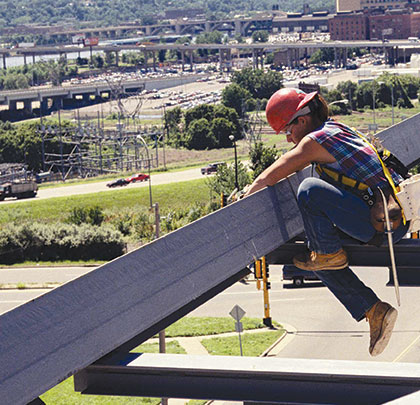It’s time to face the facts—falls happen. Most serious work-related injuries and deaths commonly result from falls that can and should be prevented. In the construction industry, falls remain the leading cause of death, accounting for 35 percent of total deaths in 2011 (OSHA).
Invest the time and the money to ensure workers are protected and prepared for working at height before they begin any work on the jobsite. By doing so, you can avoid the physical, emotional, and fiscal casualties that directly result from an accidental fall.
THE REAL COST OF FALLS
All of your workers at height, including those that work on overhead platforms, elevated workstations or above holes in the floor, are at risk for serious falls.
Beyond the human cost, falls have detrimental economic consequences for your business. Each year, companies lose millions of dollars in lost work, insurance premiums, litigation, and liability claims as a result of falls. In addition to fines and increased costs, falls can take a tremendous toll on workers’ mental and emotional health, preventing them from performing at their best. They also impact productivity and corporate reputation and can be a deciding factor in job bids.
The bottom line: the complex cost of falls is not worth the risk of leaving your team ill-equipped and ill-prepared.
REDUCE THE CHANCE OF FALLS
Don’t overlook the dual value of fall protection—safeguarding workers and staying in business. Invest in prevention. Workers’ lives depend on proper safety equipment, proper training, and a comprehensive fall protection plan. By being proactive and implementing a fall protection plan, your benefits will extend beyond worker safety.
The solution is to do more than the bare minimum for compliance. Your actions should tell employees that the company truly values safety and is investing in their health and well-being. Workers will invest in you when they see you have invested in them.
Follow these three simple steps to establish a strong fall protection program that pays off in more ways than one.
Plan. Planning seems like an easy enough step, but there are many aspects to consider when developing a fall protection strategy.
Start simple. First, decide how the job will be done, what specific tasks will be involved, and what fall protection equipment may be required to complete each task. This involves analyzing the work zone. Assess the different areas of high risk, such as holes or leading edges, and then determine what systems and equipment are needed to prevent or mitigate fall hazards.
Another key component of the planning stage is creating a comprehensive written fall protection plan. For some, it is not feasible to utilize conventional means of fall protection (as in OSHA 1926.501 (b) (2), (b) (12), and (b) (13)). In such cases, OSHA requires that a Qualified Person (OSHA 1926.502(k)) create a written plan.
The plan should include possible hazards, fall protection systems that will be utilized to mitigate those hazards, and a rescue plan should an employee become suspended after a fall. The plan should be easily accessible at all times and all personnel should be acquainted with the procedures outlined in the plan. While not required for all circumstances, having a plan that your workers are familiar with will ensure they know the proper safety measures in an emergency. It also acts as a good record to give to OSHA should there ever be an incident.
Provide. By now, you should be quite familiar with OSHA’s new regulation for residential construction—workers who are 6 feet or more above lower levels are required to use fall protection equipment, such as personal fall arrest systems, guardrails, or safety nets.
It’s your responsibility to select the right job-specific fall protection equipment and ensure workers use it. Supply them with durable fall protection products that pair comfort with reliability. You want high-performing gear that lasts, so choose quality over cost. Remember to also consider the equipment’s ease of use. If you are uncomfortable wearing a certain harness throughout the workday, your workers will be too.
Train. The right safety equipment is only beneficial when it’s accompanied by adequate training. You can help prevent falls by ensuring workers learn the proper setup and safe use of fall protection equipment.
Accelerate workers’ understanding by providing hands-on training that mimics actual work conditions. Let workers strap in and experience what the equipment actually feels like. They’ll also learn what components of the equipment need to be inspected before each use. Supplementing hands-on training with classroom instruction will help workers easily apply what they’ve learned to real situations.
Expand your training regimen beyond equipment usage and include education about potential hazards and proper procedures as well. Use the many online training resources to your advantage. The value of knowledge about height safety is priceless.
Don’t risk the lives of your workers and the life of your company by failing to implement a robust fall protection program. Preventing a fall or arresting a fall is as simple as one-two-three—plan, provide, train. ■
About The Author:
Shawn Cherri is a senior training specialist at Capital Safety, and can be contacted at scherri@capitalsafety.com. Capital Safety is a leading designer and manufacturer of height safety and fall protection equipment. Capital Safety also offers training courses with 20 operating sites worldwide. For more information, call 800.328.6146, or visit www.capitalsafety.com.
_________________________________________________________________________
Modern Contractor Solutions, February 2013
Did you enjoy this article?
Subscribe to the FREE Digital Edition of Modern Contractor Solutions magazine.



